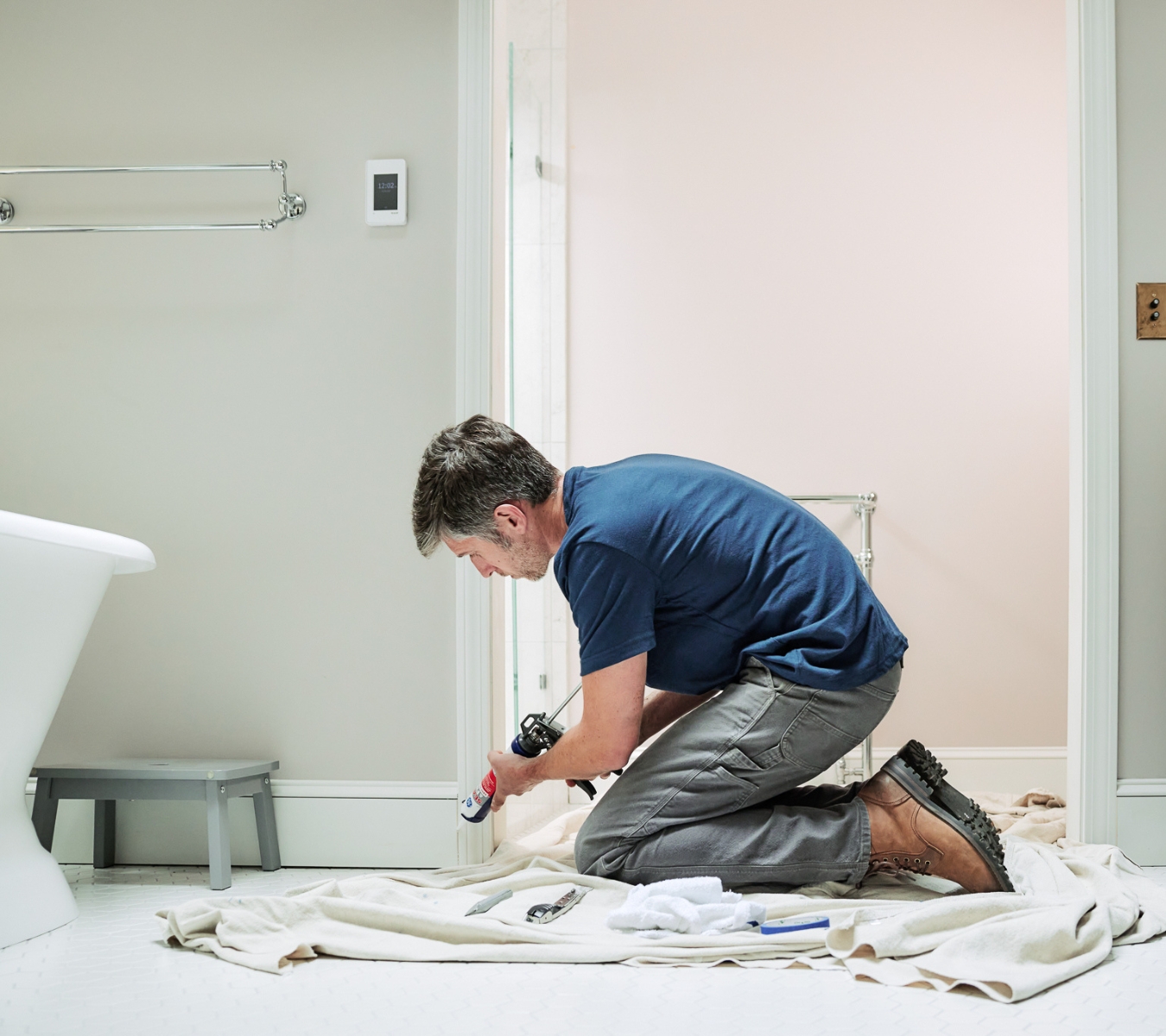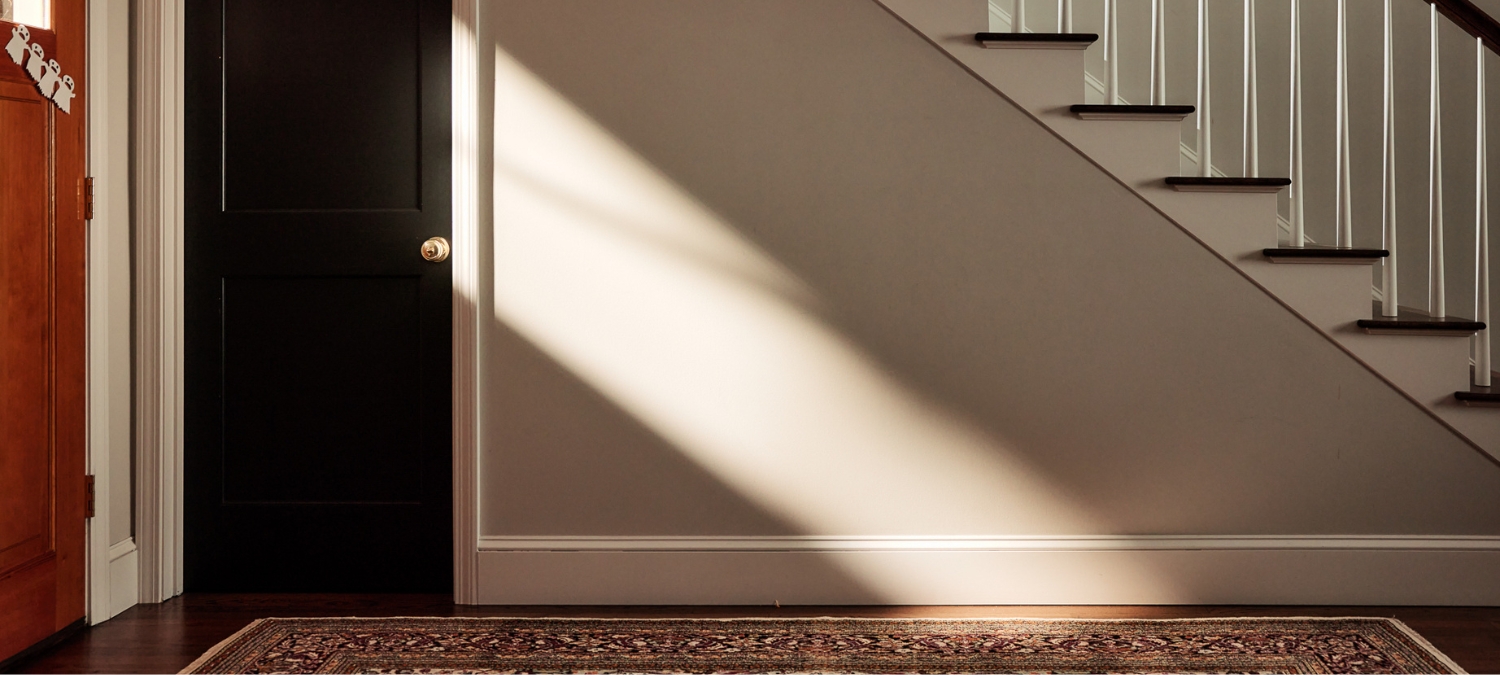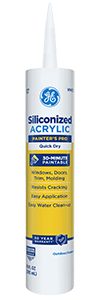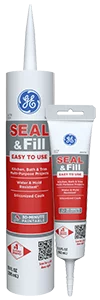Note: This DIY article is provided as a general guide only and is not intended to take the place of product-specific installation procedures; always follow applicable manufacturers’ instructions. Depending on your home’s age and condition, location within the home, and other potential factors, repairs and/or upgrades or other services may be necessary prior to the beginning and/or completion of your project that may involve the services of a home improvement professional. This article does not include advice pertaining to local building codes and/or any related inspections.
Baseboard gaps and shadow lines make a room look unfinished. With the right caulk, tools, and timing, you can close those gaps cleanly and paint within the hour. This guide shows how to caulk baseboards step by step for a seamless, professional result.
Choose the right caulk for baseboards
The first step to a clean, professional line is choosing the right material for the job. Most baseboards are painted, which means you need a paintable caulk for baseboards that bonds strongly and blends into the trim once painted.
For standard interior trim, a high-quality acrylic or paintable hybrid provides you with balanced flexibility, adhesion, and a smooth finish:
- Good: GE Seal & Fill Multi-Purpose Kitchen & Bath Caulk – easy to apply, and ready to paint in 30 minutes. Ideal for most indoor gaps along walls and trim.
- Better: GE Painter’s Pro Quick Dry Siliconized Acrylic – 30-minute paint-ready, smooth to tool, and built for fast painting schedules.
- Best: GE Pro Seal Max Kitchen & Bath – a SMP hybrid that offers silicone-level durability and adhesion, with added flexibility for joints that experience movement or moisture. A strong choice for baseboards near kitchens, baths, or humid areas.
However, if your baseboard joint will stay visible and unpainted or sits near frequent moisture-exposure, such as along tile or utility trim, use a 100% silicone sealant. It resists moisture, cleans easily, and keeps its color, but it cannot be painted.
Paintable caulks remain the preferred choice for most interior baseboards. They finish clean, accept paint evenly, and deliver the seamless look that defines a professional result.

Most interior baseboards are painted, so use a paintable caulk or hybrid for a seamless finish you can color-match. Try GE Seal & Fill Multi-Purpose Kitchen & Bath Caulk: paintable, easy to apply, and 30-minute paint-ready.
Gather your tools and prep supplies for caulking baseboards
Have every tool ready before you start. Once the bead begins, you won’t want to stop to find tape or a rag.
You’ll need:
- A caulk gun
- Your chosen caulk for baseboards
- A GE Sealant Remover Tool
- A GE Sealant Smoothing Tool or a GE Cartridge Opener & Smoothing Tool
- Painter’s tape
- Backer rod for gaps about ¼ inch or wider
- Isopropyl alcohol and lint-free cloths
- A utility knife
- Disposable rags or paper towels for quick cleanup
Laying out your tools before you begin keeps the job controlled and efficient.
Know exactly where to caulk baseboards (and where not to)
Before you pick up the gun, know which joints to seal and which to leave open.
Caulk these joints:
- Top edge of the baseboard, where it meets the wall. This is the primary joint that hides shadow gaps and gives the baseboard a clean, finished line.
- Inside and outside corners, where baseboards meet or turn. A bead here can help limit hairline cracks and seal small gaps caused by wall movement.
- Splices or scarf joints, where two baseboard lengths meet mid-wall. A narrow, tooled bead bridges the seam and helps the pieces read as one continuous line.
Be cautious here:
- Baseboard to hardwood floor: The flooring expands and contracts with humidity. A rigid sealant can crack. Leave it unsealed or add shoe molding to cover the gap while allowing movement.
- Baseboard to tile, vinyl, or laminate: A thin bead can block debris and moisture, but expect to reapply it periodically as the area flexes with use.
Prep surfaces for strong adhesion and clean lines
You want a clean, dry, and correctly shaped joint before caulking baseboards. Proper prep improves adhesion and helps the bead lay down in a smooth, controlled line.
Remove old material
Use your GE Sealant Remover Tool to gently lift cracked or loose caulk. If residue remains, scrape lightly and wipe the area clean. Never apply a new sealant over a failed bead.
Clean and dry the joint
Vacuum dust and debris from the gap. On non-porous surfaces such as painted trim or tile, wipe with isopropyl alcohol and remove any remaining film.
Let the joint dry completely before applying new caulk.
Control joint depth
For gaps around 1/4 inch or wider, press in the backer rod first so the joint depth is about half the width.
This supports the bead and helps prevent it from sinking as it cures.
Mask for a straight line
Once the joint is clean, dry, and sized correctly, apply painter’s tape along both sides of the joint along the line you want to see.
Press the tape edges firmly to prevent seepage.
How to caulk baseboard trim
Follow these steps to learn how to apply caulk to baseboards using a clean, continuous bead so that it blends in once painted by working steadily, section by section, and tooling each bead before it begins to skin.
Cut the nozzle small and load the gun
Cut the tip of the cartridge nozzle at a narrow 45-degree angle using the built-in cutter on your caulk gun or the GE Cartridge Opener & Smoothing Tool. Start with a small opening; you can widen it later.
Next, pierce the inner seal and load the cartridge. Rotate the nozzle so the cut edge lines up with the joint.
Run a short test bead on scrap to check flow and bead size, then adjust until the caulk lays down smoothly and evenly.

Run a steady bead and smooth in one clean pass
Hold the gun at roughly 45 degrees to the joint and pull it toward you at a steady pace.
Keep even trigger pressure so the bead just fills the gap, not thin and sticking out past the trim.
Work in short runs, about three to four feet at a time, so you can tool before a skin begins to form.
Right after applying the bead, use the GE Sealant Smoothing Tool or the smoothing edge of the GE Cartridge Opener & Smoothing Tool.
Select the profile edge you want. A slight concave finish works well for baseboards.
Set the tool at the start of the bead, press lightly, and pull in one continuous motion to seat the sealant and shape the surface. This step removes excess and leaves a consistent line.
Remove the tape and confirm the line
Remove the painter’s tape while the bead is still wet, pulling it away from the joint at an angle.
If a fine string of caulk lifts, snap it cleanly with the tool instead of dragging it along the surface.
Paint and cure timing if you are painting
Timing matters in baseboard caulking. Paint too early, and the paint film can wrinkle or pull. Wait too long in a dusty room, and contaminants may settle on the bead before coating.
Follow the product label or Technical Data Sheet for the exact paint-ready time. Paintable hybrids such as Pro Seal Max Kitchen & Bath may need around 60 minutes before coating, depending on temperature and humidity.
Also, make sure to choose a paint compatible with your sealant and trim. Consult the paint and sealant TDS before you coat.
Fix common baseboard caulking mistakes
Even when you are being careful, small errors can show up after caulking baseboards. Here’s how to recognize them and what to do next.
Wavy or wide lines
This usually happens when the nozzle opening is too wide or the bead is applied too slowly.
If the caulk spreads or ripples, lighten your trigger pressure or move the gun a bit faster to control the flow, and work in shorter sections.
For your next cartridge, start with a smaller nozzle opening to make bead control easier.
Voids or sinking
If the caulk sinks into the joint or leaves gaps, the bead was too deep.
Press the backer rod into wider gaps before sealing so the caulk sits at the correct depth and cures without pulling away.
Paint won’t stick
If paint beads or flakes from the caulk, you may have used a non-paintable silicone on paint-grade trim.
Remove the old sealant and reapply with a paintable acrylic or hybrid so paint bonds properly.
Ridges or drag marks after tooling
A common cause of this is an overworked bead.
Tool the bead once with a steady pull using the GE Sealant Smoothing Tool to seat the material and leave a uniform surface.
Get everything you need for clean baseboard caulking, with reliable tools that keep your bead steady and clean. Find GE Sealants and tools at a retailer near you in the U.S. or Canada.




